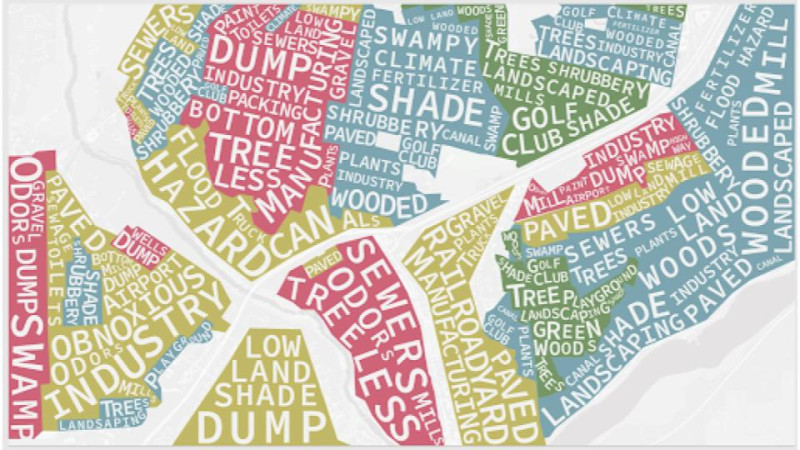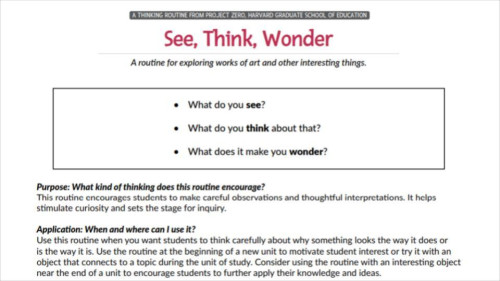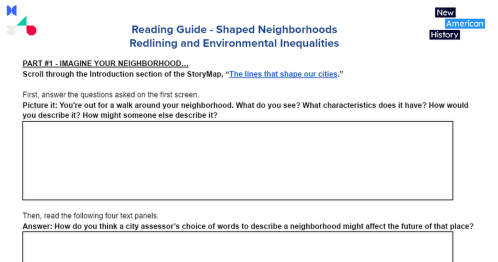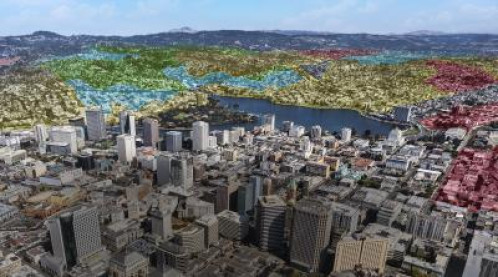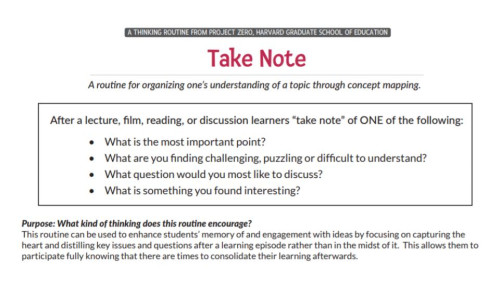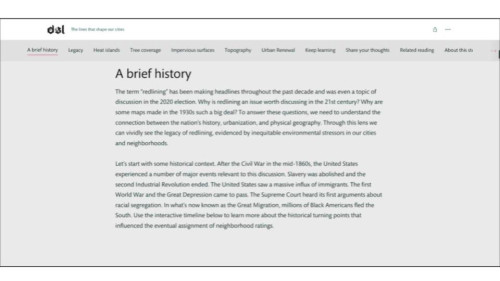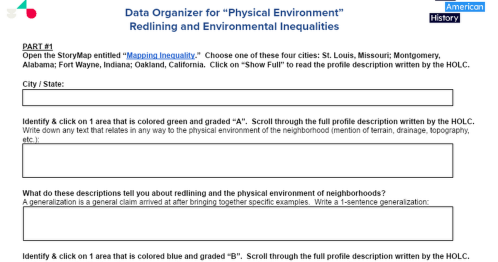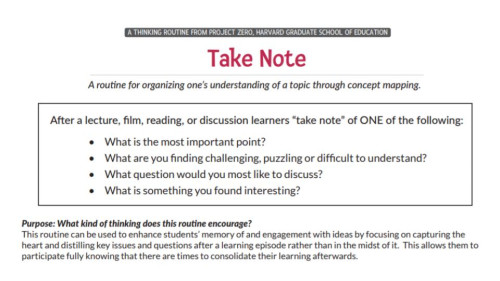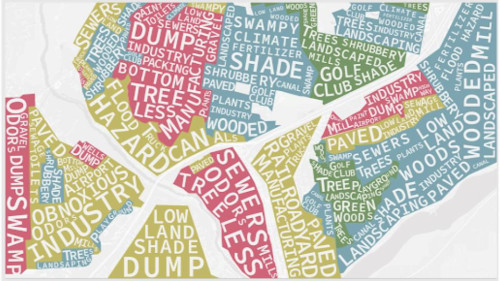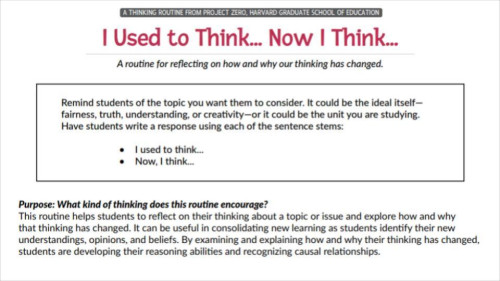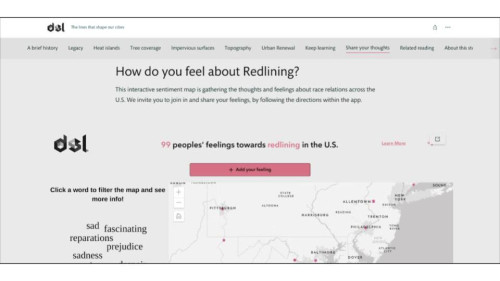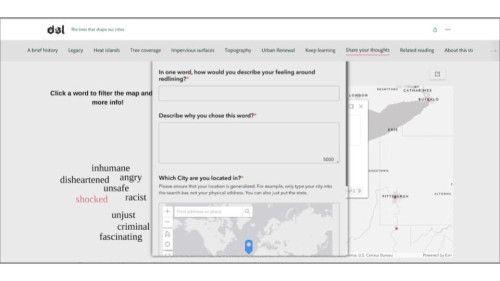This work by New American History is licensed under a Attribution-NonCommercial-ShareAlike 4.0 (CC BY-NC-SA 4.0) International License. Permissions beyond the scope of this license may be available at newamericanhistory.org.
The lines that shape our cities: Redlining & Environmental Inequalities
View Student Version
Standards
C3 Framework:D2.His.3.6-8. Use questions generated about individuals and groups to analyze why they developed, and the developments they shaped, are seen as historically significant.D2.His.3.9-12. Use questions generated about individuals and groups to assess how the significance of their actions changes over time and is shaped by the historical context.
National Council for Social Studies:Theme 2 - TIME, CONTINUITY, AND CHANGETheme 5 - INDIVIDUALS, GROUPS, AND INSTITUTIONS
National Geography Standards: Standard 1 - How to use maps and other geographic representations, geospatial technologies, and spatial thinking to understand and communicate informationStandard 12 - The processes, patterns, and functions of human settlement
College Board AP U.S. History (Fall 2020):HISTORICAL THINKING SKILLS COVERED:SKILL 4.A – Identify and describe a historical context for a specific historical process or development.SKILL 5.A: Identify patterns or connections between historical developments.HISTORICAL DEVELOPMENTS COVERED:TOPIC 8.4 - Economy after 1945:KC-8.3.I.B - As higher education opportunities and new technologies rapidly expanded, increasing social mobility encouraged the migration of the middle class to the suburbs and of many Americans to the South and West. The Sun Belt region emerged as a significant political and economic force.TOPIC 8.15 - Continuity & Change in Period 8:KC-8.2.I - Seeking to fulfill Reconstruction-era promises, civil rights activists and political leaders achieved some legal and political successes in ending segregation, although progress toward racial equality was slow.
College Board AP Human Geography (Fall 2020):COURSE SKILLS COVERED:SKILL 2: Spatial Relationships - Analyze geographic patterns, relationships, and outcomes in applied contexts.SKILL 3: Data Analysis - Analyze and interpret quantitative geographic data represented in maps, tables, charts, graphs, satellite images, and infographics.REQUIRED COURSE CONTENT:TOPIC 6.8 - Urban Sustainability:IMP-6.D.1 - Praise for urban design initiatives includes the reduction of sprawl, improved walkability and transportation, improved and diverse housing options, improved livability and promotion of sustainable options. Criticisms include increased housing costs, possible de facto segregation, and the potential loss of historical or place characterTOPIC 6.10 - Challenges of Urban Changes:SPS-6.A.1 - As urban populations move within a city, economic and social challenges result, including: issues related to housing and housing discrimination such as redlining, blockbusting, and affordability; access to services; rising crime; environmental injustice; and the growth of disamenity zones or zones of abandonment.
EAD RoadmapTheme: Institutional and Social Transformation Design Challenge: Motivating Agency, Sustaining the Republic
Suggested Grade Levels:High School (9-12), especially Advanced Placement U.S. History and Human Geography courses
Suggested Timeframe:Two 90-minute class periods
Suggested Materials:Internet access via laptop, tablet or mobile device, projection screen
Key Vocabulary
Assessor - a person who estimates the value of something, in this case land
Home Owners’ Loan Corporation (HOLC) - an agency created in 1933 by U.S. President Franklin D. Roosevelt’s New Deal that attempted to prevent foreclosures by refinancing home mortgages in default; created a color-coded grading system that assessed the credit-worthiness of city neighborhoods
Impervious surfaces - man-made land surfaces such as sidewalks, roads, parking lots that are covered by materials that water cannot penetrate, such as asphalt, concrete, or gravel
The New Deal - President Franklin D. Roosevelt’s program to help solve the economic problems triggered by the Great Depression
Redlining - the practice of mortgage lenders of drawing red lines around portions of a map to indicate areas or neighborhoods in which they do not want to make loans.
StoryMap - a web-based map integrating maps, legends, text, images, and multimedia elements to help users explore content and visualize data.
Suburbs - an area outside of a city that is primarily residential
Topography - the arrangement of physical features of a land’s surface
Tree canopy coverage - the proportion of an area shaded by trees
Urban heat island - occurs when a city experiences much warmer temperatures than nearby rural areas
Read for Understanding
Teacher Tips:
This Learning Resource includes language in the body of the text to help adapt to a variety of educational settings, including remote learning environments, face-to-face instruction, and blended learning.
If you are teaching remotely, consider using videoconferencing to provide opportunities for students to work in partners or small groups. Digital tools such as Google Docs or Google Slides may also be used for collaboration. Rewordify helps make a complex text more accessible for those reading at a lower Lexile level while still providing a greater depth of knowledge.
This Learning Resource uses maps from the research project Mapping Inequality: Redlining in New Deal America. The maps capture the color-coded system created in the 1930s by the Home Owners’ Loan Corporation to determine which city neighborhoods were good credit risks for home loans. The HOLC data helped set the rules for 100 years of real estate practice and helps explain the social and economic inequality that has existed in U.S. cities since the Great Depression. As a companion to “The lines that shape our cities,” a StoryMap that connects present-day environmental inequalities to redlining policies of the 1930s
This Resource also uses Bunk Connections, a feature that connects two articles on the Bunk platform through their shared idea, place, or time period.
In addition, this Learning Resource uses Turn and Talk to allow students to work with an “elbow partner” for brief collaborations. In addition, this Learning Resource uses “Thinking Routines” from Project Zero, a research center at the Harvard Graduate School of Education that has developed learning strategies that encourage students to add complexity to their thought processes. For an overview of Project Zero’s methodology, you may want to read its Exploring Complexity Bundle. Specifically for this lesson, students will use these thinking routines: Creative Question Starts, Take Note, See, Think, Wonder, I Used To Think… Now I Think.
Lastly, this Learning Resource follows a variation of the 5Es instructional model, and each section may be taught as a separate learning experience, or as part of a sequence of learning experiences. We provide each of our Learning Resources in multiple formats, including web-based and an editable Google Doc for educators to teach and adapt selected learning experiences as they best suit the needs of your students and local curriculum. You may also wish to embed or remix them into a playlist for students working remotely or independently.
For Students:
While many books, essays and articles have been written about the socio-economic effects of redlining, more recently researchers are using Geographic Information Systems (GIS) analysis to uncover relationships between redlined areas and environmental conditions such as tree canopy coverage, temperature, infrastructure, and topography. This type of analysis can help identify correlations between historically redlined areas and environmental inequalities.
Engage
How can words shape neighborhoods?
In the 1930s, city assessors supported by the federal government under The New Deal rated more than 200 city neighborhoods. The ratings were based on how good of an investment they would be for banks and real-estate developers: “A” meant the “best” investment, “D” meant the investment was “hazardous.” The work of these assessors shaped the future social, economic, and environmental life of these places.
First, view an excerpt from this StoryMap as connected in Bunk. Then, go back and examine the WordCloud that shows common descriptors for each of the four ratings.
Using the reading and the WordCloud, your teacher will lead a discussion using the “See, Think, Wonder” thinking routine. Share your ideas in small groups or with the whole class. If working remotely, you may use breakout rooms through videoconferencing or share via a collaborative document such as Google Docs or Google Slides.
After the discussion, read the introduction to this StoryMap, entitled “The lines that shape our cities”.
As you read, make a copy and complete Part 1 of this Reading Guide.
Next, in a group of 3 or 4, complete Part 2 of the Reading Guide, which uses Project Zero’s “Creative Question Starts”.
After you complete Part #2, each group shares their best question and their reflections with the whole class.
If working remotely, you may use breakout rooms through videoconferencing or share via a collaborative document such as Google Docs or Google Slides.
Your teacher may ask you to record your answers on an exit ticket.
Explore
How has redlining been connected to environmental inequalities?
During the Great Depression, the administration of U.S. President Franklin D. Roosevelt started implementing social aid programs as part of The New Deal to help struggling Americans. One such agency was the Home Owners Loan Corporation (HOLC). It gave more than one million emergency refinancing loans to homeowners between 1933 and 1936, including loans to people of color and immigrants. The HOLC also created a color-coded mapping system that rated neighborhoods based on how good of an investment they would be for banks and real-estate developers: Green indicated the “best” investment opportunities, and red indicated“hazardous.” However, the HOLC’s process for making these maps was subjective and was often based on the racial and ethnic composition of neighborhoods. Out of the HOLC color-coded map system came the term redlining, and historians continue to debate its impact on city neighborhoods today.
Recent scholarship has connected the socio-economic effects of redlining with environmental inequalities today. Learn more about these relationships by selecting the “Legacy” tab of the American Panorama StoryMap entitled “The lines that shape our cities.”
Choose one of the four case studies that investigate the relationship between redlining and the urban environment today:
- Urban heat islands in St. Louis, Missouri
- Tree canopy coverage in Montgomery, Alabama
- Impervious surfaces in Fort Wayne, Indiana
- Topography in Oakland, California
Then, find the tab that relates to your chosen case study. Select and read through all of the corresponding information.
Make a copy and complete this Data Organizer as you read and examine the case study.
When you finish the Data Organizer, use your findings to answer one of the questions below, using the “Take Note” Thinking Routine:
- What is the most important point?
- What are you finding challenging, puzzling, or difficult to understand?
- What question would you most like to discuss?
- What is something you found interesting?
To share your response, your teacher may provide access to a Google Doc discussion board, or allow you to collaborate on a Google Slides set. Your teacher will debrief by reviewing the main ideas of each piece and by reading back student responses to the class and asking follow-up questions or by asking you to turn and talk to a partner to share your answers.
Your teacher may ask you to record your answers on an exit ticket.
Explain
How did redlining, as defined by the HOLC maps, affect a neighborhood’s physical environment?
Click on the “Brief History” tab of “The lines that shape our cities”.
Read through this section carefully. Make a copy and complete this 3-2-1 graphic organizer after you read.
After reading about the broader historical context of how the HOLC maps and ratings originated redlining, examine those maps more closely. Open the map entitled “Mapping Inequality.” Choose one of the four cities addressed in the StoryMap and previous “Explore” section of this learning resource: St. Louis, MO; Montgomery, AL; Fort Wayne, IN; or Oakland, CA.
Use the search bar in the upper right corner to find data on the city you selected.
Once the data appears, click on one area that is colored green and graded “A.” Click on “Show Full” to read the profile description created by the HOLC.
Note: If you choose St. Louis, use the map for East St. Louis, Illinois. (There are no clarifying remarks for St. Louis, Missouri.)
Repeat for one area of the same city that is colored red (D), yellow (C), and blue (B).
Make a copy and complete this Data Organizer, which will organize and guide your interpretation of the data.
Complete the Exit Questions in Part 2 of the Data Organizer.
Then, answer this question as a large group discussion led by your teacher with your class:
How did the HOLC’s maps affect the development of a neighborhood’s physical environment?
Your teacher will debrief by reading back student responses to the class and asking follow-up questions or by asking you to turn and talk to a partner to share your answers.
Your teacher may ask you to record your answers on an exit ticket.
Elaborate
How did redlining contribute to the creation of the suburbs?
The HOLC’s maps and rating system contributed to the creation of suburbia in America. Learn more about this relationship by exploring this Bunk Connection. Watch “The Disturbing History of the Suburbs” and read “American Green.”
Before you read and watch, review the questions in the “Take Note” Thinking Routine. After you read and watch, you will choose one of the following questions to answer. As you read, don’t try to take notes at the same time, just focus on becoming fully engaged in the reading:
- What is the most important point?
- What are you finding challenging, puzzling, or difficult to understand?
- What question would you most like to discuss?
- What is something you found interesting?
When you finish reading, answer one of the “Take Note” questions above. Your teacher may provide access to a Google Doc discussion board, or allow you to collaborate on a Google Slides set. Your teacher will debrief by reading back student responses to the class and asking follow-up questions or by asking you to turn and talk to a partner to share your answers.
Lastly, you will end with a discussion of this Exit Question, using ideas from the reading and clip:
How did redlining contribute to the creation of the suburbs?
Your teacher may ask you to record your answers on an exit ticket.
Applying what you’ve learned from this lesson, your teacher will lead a class discussion using the “I Used To Think…Now I Think” thinking routine. You will explain how your thinking on redlining and environmental inequalities has changed since the start of this lesson.
Click on the “Share your thoughts” tab of the StoryMap called “The lines that shape our cities.”
Then, click on 3 different words located to the left of the interactive sentiment map. For each word, read the comment box that accompanies it. Make a copy and complete this Map Guide to organize your thoughts and reflections.
After you complete the Map Guide, click on the red “Add your feeling” button on the sentiment map. Complete the text box to submit your feelings about redlining.
Your teacher may ask you to record your answers on an exit ticket.
Citations:
“The Disturbing History of the Suburbs: Adam Ruins Everything.” YouTube. Adam Ruins Everything, October 4, 2017. https://youtu.be/ETR9qrVS17g.
“The Lines That Shape Our Cities.” ArcGIS StoryMaps. Esri, March 8, 2022. https://storymaps.arcgis.com/stories/0f58d49c566b486482b3e64e9e5f7ac9.
“Project Zero's Thinking Routine Toolbox.” PZ's Thinking Routines Toolbox | Project Zero. Accessed July 12, 2022. https://pz.harvard.edu/thinking-routines.
Robert K. Nelson, LaDale Winling, Richard Marciano, Nathan Connolly, et al., “Mapping Inequality,” American Panorama, ed. Robert K. Nelson and Edward L. Ayers, accessed July 7, 2022, https://dsl.richmond.edu/panorama/redlining.
Steinberg, Ted. “American Green.” Longreads. Longreads, July 12, 2019. https://longreads.com/2019/07/18/american-green/.
View this Learning Resource as a Google Doc



